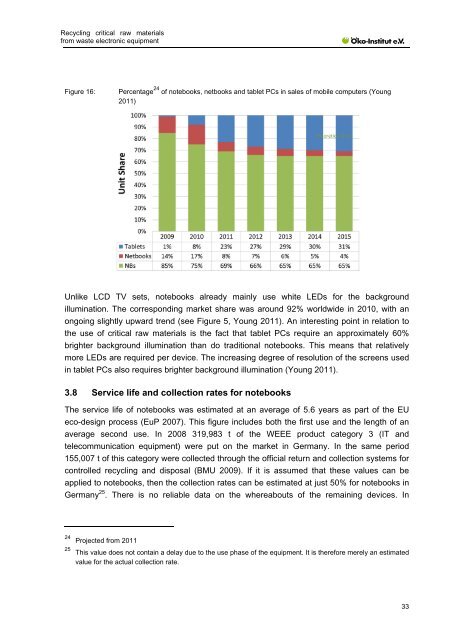Recycling critical raw materials from waste electronic equipment
Recycling critical raw materials from waste electronic equipment
Recycling critical raw materials from waste electronic equipment
You also want an ePaper? Increase the reach of your titles
YUMPU automatically turns print PDFs into web optimized ePapers that Google loves.
<strong>Recycling</strong> <strong>critical</strong> <strong>raw</strong> <strong>materials</strong><br />
<strong>from</strong> <strong>waste</strong> <strong>electronic</strong> <strong>equipment</strong><br />
Figure 16: Percentage 24 of notebooks, netbooks and tablet PCs in sales of mobile computers (Young<br />
2011)<br />
Unlike LCD TV sets, notebooks already mainly use white LEDs for the background<br />
illumination. The corresponding market share was around 92% worldwide in 2010, with an<br />
ongoing slightly upward trend (see Figure 5, Young 2011). An interesting point in relation to<br />
the use of <strong>critical</strong> <strong>raw</strong> <strong>materials</strong> is the fact that tablet PCs require an approximately 60%<br />
brighter background illumination than do traditional notebooks. This means that relatively<br />
more LEDs are required per device. The increasing degree of resolution of the screens used<br />
in tablet PCs also requires brighter background illumination (Young 2011).<br />
3.8 Service life and collection rates for notebooks<br />
The service life of notebooks was estimated at an average of 5.6 years as part of the EU<br />
eco-design process (EuP 2007). This figure includes both the first use and the length of an<br />
average second use. In 2008 319,983 t of the WEEE product category 3 (IT and<br />
telecommunication <strong>equipment</strong>) were put on the market in Germany. In the same period<br />
155,007 t of this category were collected through the official return and collection systems for<br />
controlled recycling and disposal (BMU 2009). If it is assumed that these values can be<br />
applied to notebooks, then the collection rates can be estimated at just 50% for notebooks in<br />
Germany 25 . There is no reliable data on the whereabouts of the remaining devices. In<br />
24 Projected <strong>from</strong> 2011<br />
25 This value does not contain a delay due to the use phase of the <strong>equipment</strong>. It is therefore merely an estimated<br />
value for the actual collection rate.<br />
33

















